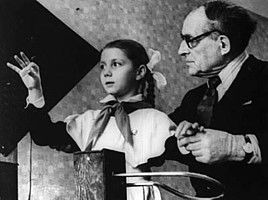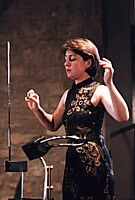| Title: 2 Albums At Once? That's Waits' Way Source: Chicago Tribune (USA) May 5, 2002 by Greg Kot. Transcription as published on http://www.chicagotribune.com/. Date: Telephone interview. Published:May 5, 2002 Keywords: Alice/ Blood Money, Theremin, calliope |
2 Albums At Once? That's Waits' Way
Tom Waits' next pair of albums -- the 18th and 19th of a career with more left hooks than Muhammad Ali's -- won't be released until Tuesday. But the gravel-voiced singer is already pondering his next move.
"I'm going to tap into the kids market next," Waits vows in a phone interview from the Los Angeles home he shares with his wife and musical collaborator, Kathleen Brennan, and their three children. "I got a fan letter from a 9-year-old girl in Indiana. She wrote, 'I love your voice, you sound like something between a cherry bomb and a clown. P.S. I got in trouble playing your records at school. Please call my teacher.' I called the teacher and left a message, but she didn't return my call."
Waits is getting most of his calls returned these days. After 29 years of profound, and sometimes profoundly disturbing, musicmaking, this bard of the misbegotten finds himself a platinum-selling artist for the first time. Not that success has dimmed his penchant for perversity.
On Tuesday, his latest albums -- "Alice" and "Blood Money" (both on Anti/Epitaph) -- will be released. Originally conceived as the scores for two Robert Wilson plays(1), the albums were recorded concurrently last summer with an assortment of oddball instruments and adventurous musicians. It's highly unusual for an artist to release a double CD, let alone two distinct albums, on the same day. But Waits has earned the opportunity to indulge himself.
His last album, "Mule Variations" (1999), sold a million copies, charted higher than any of his previous releases (No. 30 on the Billboard album chart) and snagged his second Grammy Award, for best contemporary folk album (which sounds like yet another failed attempt to categorize an essentially uncategorizable artist's music). But if this late-arriving commercial success gave Waits greater license to release two albums at once, he shrugs it off.
"If you're gonna heat up the stove, you might as well make more than one pancake," he says. "It's a lot of work to go into a studio, mobilize a lot of people and equipment. So I figured once we got in there, . . . let's do another one while the motor is running. Eventually, no one will care what day they came out on. If it's a good idea, I'll take credit for it. If it isn't, I'll blame it on somebody else."
Getting it done right
Waits makes it clear that he was never completely satisfied with the way the songs written by him and Brennan were performed in the original stage productions.
"Writing songs for other people is just mortifying at times. You stand by and watch other people completely butcher them," he says. "Sometimes they're completely elevated. But I figured I could improve upon most of them."
"Blood Money" is derived from Wilson's staging of the 19th Century play "Woyzeck," about a German soldier driven to madness and murder. It premiered in Denmark in 2000. "Alice" is a lyrical meditation on the relationship between author Lewis Carroll and young Alice Liddell, the girl who inspired "Alice in Wonderland" and "Through the Looking Glass." The play was first staged in Germany in 1992, with an orchestra assembled by Waits.
"The best part about it was that we had a woman from Moscow who played the theremin who was the granddaughter of Leon Theremin(2) , the man who invented the instrument," Waits recalls of the original production. "She was like a little Russian doll, and she was just amazing. You'd think Leon Theremin's granddaughter would have a rosewood or ebony theremin with inlaid mother of pearl, but hers looked like a hot plate. It was painted in a drab color with somebody's initials carved into it, and a car aerial protruding from the box. Inside, all the electrical connections and circuitry were attached with cut-up pieces of a beer can, folded over the wires. She was a true Russian, the musical equivalent of the good butcher who uses every part of the cow."
Waits' obsession with misfit instruments began in the early '80s, soon after he met Brennan, who encouraged him to explore a wider spectrum of sounds. The result was groundbreaking works such as "Swordfishtrombones" (1983) and "Rain Dogs" (1985). Once a boozy balladeer who specialized in crafting two types of songs -- "grim reapers and grand weepers" -- Waits pioneered what could only be called "avant-cabaret" on those '80s albums.
To give "Alice" and "Blood Money" their distinctive characters, Waits introduced a few more oddities to his sound-making arsenal: a stroh violin(3) (a violin crossed with a brass horn), a pod (a four-foot seed pod from Indonesia, used as a percussion instrument) and a 1929-vintage pneumatic calliope.
Musical merry-go-round
Where does one buy a pneumatic calliope, with 57 whistles?
"In Iowa, actually," Waits says. "Back of a flatbed truck. It was a small, red-suspender band, their sleeves held up with elastic, wearing straw hats. Greg Cohen(4), who's married to my wife's sister and has been my bass player for many years, asks if it's for sale. `Absolutely.' So he gives me the phone number. Says his wife would kill him if he purchased a calliope. So he decided to let my wife kill me, instead. I paid 2 grand for it, and it needed work. It's just like buying a used car . . . a background in car repair would be more advantageous than a background in music in working with it, because it's all hoses and pipes. It took four guys to carry it . . . when we played it in the studio, people for miles around complained of the noise."
The instrument's distinctive merry-go-round wail, along with the swat of the Indonesian seed pod and the chiming of marimbas, bells and gongs, sets the otherworldly tone for "Blood Money." The album is a descent into Dante's "Inferno" with a circus carny as a tour guide, by turns sinister and sarcastic. "Alice" is mellower and dreamier, a chamber orchestra "Fantasia" that is, at heart, a love story set to music -- albeit a tragic and disturbing one: "And my eyeballs roll this terrible terrain/ We're all inside a decomposing train/ And your eyes will die like fish/ And the shore of your face will turn to bone."
Out of this world
These are beautiful songs that tell the listener terrible things. At times they sound like transmissions from another world, where dusty 78-rpm records spin in the antique parlor of the imagination. At other moments, this mystical weirdness cuts with avant-garde force: Who else is making music quite like this today?
"The best comment on a piece of music is usually made through another piece of music," Waits says. "Songwriters don't go to school; they sit around and listen to other people's records. You stick your ear in the speaker, and try to figure out how somebody did something. It's like studying footprints or trails or ancient maps. Usually what you hear is the inaccurate attempt to emulate someone else, and then you try to emulate that. I could tell you I'm doing my best Jimmy Durante, or my best Eric Burdon on this album. And you're thinking, `Damn! Really? I didn't recognize the profile.' And you'd be absolutely right, because I don't fit the profile. But in the process, something else happens. Because what intrigues me is not the emulation, but the possibility of surprise."
Notes:
(1) Scores for two Robert Wilson plays: Alice (the play) premiered on December 19, 1992 at the Thalia Theater, Hamburg/ Germany. Further reading: Alice. Woyzeck (the play) premiered November 18, 2000 at the Betty Nansen Theatre in Copenhagen/ Denmark. Further reading: Woyzeck.
(2) The granddaughter of Leon Theremin: Lydia Kavina, "Being the granddaughter of Leon Theremin's first cousin, Lydia Kavina (1967) was the inventors last prot�g�e. At the age of 9 she started studying the instrument. She gave her first concert at the age of 14. She studied composition and graduated in 1992 and she finished post-graduate studies in 1997. Today Lydia is one of the few professional thereminists in the world and a master teacher on this instrument. She also is a composer and has premiered her own works and those of others throughout Russia, the USA, Europe and Asia." Further reading: Lydia Kavina Official Website.


L.) Lev Theremin teaching Lydia in 1976, photo by Snegirev from Lydia Kavina Official Website.
R.) Photo by Z. Chapek, 1997. From Lydia Kavina Official Website.
(3) Stroh violin: To overcome the lack of carrying power of string instruments, John M.A. Stroh introduced new "violins" in England in the early 1900s. Stroh replaced the violin's usual wooden body with a metal resonator to produce a louder, more penetrating sound. The aluminum horn at the end of the fingerboard directed this sound either into the recording horn or into the ear of the singer. The performer placed the smaller aluminum horn at his or her ear in order to hear what was being played more distinctly. Further reading: Instruments.
(4) Greg Cohen: Long time collaborator Gregory Cohen: producer and multi-instrumentalist. Working with Waits since 1979. Further reading: Who's Who?

